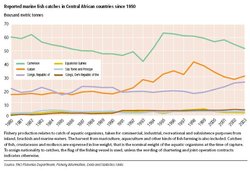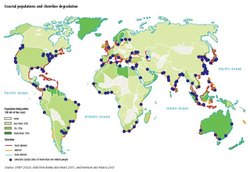Central Africa and coastal and marine environments
Contents
- 1 Introduction The principal concerns for this region are the loss and degradation of coastal (Central Africa and coastal and marine environments) habitats and the modification of marine ecosystems due to pollution (Water pollution) from land-based urban and industrial sources (including oil and natural gas development) and from the overharvesting of marine fish stocks. Pressures from continuing population growth, notably in the coastal cities, such as Douala in Cameroon and Libreville in Gabon, are having increasing impacts on the coastal environment. These impacts may be exacerbated by global climate change and sea-level rise, particularly with regard to coastal erosion – already a serious problem locally – and the inundation of low-lying coasts such as those of Cameroon and Gabon.
- 2 Overview of resources Figure 1: Global distribution of mangrove, sea-grass and coral diversity. (Source: Groombridge and Jenkins 2002; Maps prepared by UNEP-WCMC (Central Africa and coastal and marine environments) )
- 3 Endowments and opportunities
- 4 Challenges faced in realizing development
- 5 Further reading
Introduction The principal concerns for this region are the loss and degradation of coastal (Central Africa and coastal and marine environments) habitats and the modification of marine ecosystems due to pollution (Water pollution) from land-based urban and industrial sources (including oil and natural gas development) and from the overharvesting of marine fish stocks. Pressures from continuing population growth, notably in the coastal cities, such as Douala in Cameroon and Libreville in Gabon, are having increasing impacts on the coastal environment. These impacts may be exacerbated by global climate change and sea-level rise, particularly with regard to coastal erosion – already a serious problem locally – and the inundation of low-lying coasts such as those of Cameroon and Gabon.
Overview of resources Figure 1: Global distribution of mangrove, sea-grass and coral diversity. (Source: Groombridge and Jenkins 2002; Maps prepared by UNEP-WCMC (Central Africa and coastal and marine environments) )
Except for Chad and the Central African Republic, all the countries of Central Africa – Cameroon, Congo, the Democratic Republic of the Congo, Gabon, Equatorial Guinea and São Tomé and Príncipe – border the Atlantic Ocean. The mainland shores are mostly low-lying, with estuaries and mangrove swamps, especially in Cameroon and Gabon, and lagoons protected by sandy beaches. Rivers, including the Kouilou, Ogooué, Sanaga and, notably, the Congo, drain a hinterland of rainforest. The Exclusive Economic Zones (EEZs) of these countries form part of the Guinea Current Large Marine Ecosystem (LME) and have substantial fisheries resources. Total marine fish production in 2001 for all Central African countries was 113,000 t, with Cameroon being the main producer. Abundant oil and natural gas resources occur offshore, notably off Cameroon and Equatorial Guinea.
The Guinea Current LME is characterized by its tropical climate. It is considered to be highly productive, with climate being the primary driving force and intensive fishing the secondary force. The living marine resources include commercially valuable fish which are exploited at artisanal and industrial scales. The major pelagic species on the Gabon shelf is the sardinella. The demersal communities include croakers and the threadfin in nearshore waters, and sea bream and driftfish in deeper waters.
Estuaries and coastal lagoons make a major contribution to fish diversity. Mangrove forests are extensive on the sheltered coasts of Cameroon (3,060 km2) and Gabon (2,500 km2) (Figure 1). While some coral species are recorded, there are no coral reefs. Gabon has a number of coastal protected areas, including three sites protected under the Ramsar Convention on Wetlands (Ramsar) with rare and endangered mammals and birds.
The coastal areas of Central Africa have substantial hydrocarbon resources. Gabon, Equatorial Guinea and Cameroon are all significant producers and exporters of crude oil. Much of the production now comes from offshore wells. In Equatorial Guinea, production has increased from 17,000 barrels per day (bbl/d) in 1996 to an average of 350,000 bbl/d for the first half of 2004. The Democratic Republic of the Congo is now a minor producer from a well on its continental shelf. While there is concern over the longevity of the reserves in Gabon, a country almost wholly dependent on oil revenues to fund its economy, Cameroon and Equatorial Guinea are thought to have major reserves. Equatorial Guinea also has huge natural gas reserves, located off Bioko Island. Natural gas and condensate production in Equatorial Guinea has expanded rapidly in the last five years. Alba, the country’s largest natural gas field, contains 1.3 x 1012 cubic feet of discovered reserves, with probable reserves estimated to be at least at 4.4 x 1012 cubic feet.
Endowments and opportunities
 Figure 2: Reported marine fish catches in Central African countries since 1950. (Source: FAO Fisheries Department)
Figure 2: Reported marine fish catches in Central African countries since 1950. (Source: FAO Fisheries Department) Hydrocarbon resources are making an increasingly strong contribution to the economies of Central African countries and have been a key factor in improved economic growth (Economic change in Africa). Over the last decade or so, the focus of exploration has shifted from onshore to the coastal waters, where there are now many successful production ventures. The offshore Joint Development Zone, shared by São Tomé and neighboring Nigeria, is reported to hold reserves of 11,000 million barrels and could potentially yield up to 3 million bbl/d when fully operational. If successful, this development could have an immense impact on the economy of this otherwise impoverished Small Island Developing States (SIDS). Hydrocarbon resources development and production present considerable local employment opportunities.
The natural beauty, biodiversity and socio-cultural aspects of the coastal areas provide strong potential for fishery and tourism, and in particular ecotourism. Total marine fish production in 2001 for all Central African countries was 113,000 t, with Cameroon being the main producer (Figure 2). However, the large marine ecosystem (LME) shows evidence of ecosystem stress and there are major fluctuations of commercially valuable species.
Challenges faced in realizing development
Marine pollution and coastal erosion continue to disturb and destroy habitats, disrupt ecosystem functioning, cause loss of biodiversity, and affect human health and well-being. The main pollution problems are the discharge of industrial effluents and sewage, solid waste including marine-transported debris, and beach pollution. Coastal erosion has a serious impact on the low-lying coasts. Contributing causes include mangrove clearance and the reduction in sediment discharge through the damming of rivers draining the hinterland. Further entrapment of sediment in the Sanaga River basin, where Cameroon is set to construct another dam, may exacerbate erosion. Erosion can be expected to increase with sea-level rise associated with global climate change. In São Tomé, coastal erosion, exacerbated by beach-sand mining (now largely banned), has been reported to be threatening infrastructure in the southern part of the main island.
 Figure 3: Coastal populations and shoreline degradation. (Source: UNEP 2002, Data from Burke and others 2001 and Harrison and Pearce 2001)
Figure 3: Coastal populations and shoreline degradation. (Source: UNEP 2002, Data from Burke and others 2001 and Harrison and Pearce 2001) The risk of offshore oil spills from wells, terminals and tankers is a serious threat. These problems affect the islands of São Tomé and Príncipe as well as the mainland shores and their coastal waters. This risk of oil pollution comes not only from Central Africa’s offshore development but also from the huge hydrocarbon developments off neighboring Nigeria and, to a lesser extent, Angola. As well as waterborne oil pollution, air quality (Threats to atmospheric resources in Africa) is affected by the flaring of natural gas associated with oil production.
Population growth and poverty are the major factors in coastal degradation. The coastal population continues to expand, in part by inward migration. Much of this expansion is in the coastal cities of Douala in Cameroon and Libreville in Gabon, accompanied by urban sprawl and the consequent loss of formerly rich habitats (Figure 3). There is strong evidence of serious degradation in the Guinea Current coastal environment. Primary productivity surveys in coastal waters have revealed an increasing occurrence of harmful algal blooms, indicating intense eutrophication and therefore excessive nutrient loading from anthropogenic sources. Agricultural run-off contributes to increased eutrophication in the estuaries and coastal environments. The restoration of lagoons, mangroves, estuaries, deltas and tidal wetlands will benefit local communities. Not only are these habitats rich in natural resources but they are also effective filters for pollution.
The overfishing and overexploitation of transboundary and migratory fish by industrialized foreign fleets is having a detrimental effect on artisanal fishermen, and in particular on coastal communities that depend on the nearshore fisheries resource for food. This becomes particularly serious in a context of exploding demographics in the coastal areas.
Further reading
- EIA, 2005. Country Analysis Briefs. Energy Information Administration.
- FAO, 2005. FAOSTAT Database: Fisheries Data. Food and Agriculture Organization of the United Nations.
- IPCC, 2001. Watson, R.T. and the Core Writing Team (eds). Climate Change 2001: Synthesis Report. A Contribution of Working Groups I, II, and III to the Third Assessment Report of the Intergovernmental Panel on Climate Change. Cambridge University Press, Cambridge. ISBN: 0521807700
- NOAA, 2003. Guinea Current Large Marine Ecosystem, LME No. 28. United States National Oceanic and Atmospheric Administration.
- UNEP, 1999. Global Environment Outlook-2000. United Nations Environment Programme, Nairobi. ISBN: 1853835889
- UNEP, 2002. Africa Environment Outlook: Past, Present and Future Perspectives. United Nations Environment Programme, Nairobi. ISBN: 9280721011
- UNEP, 2006. Africa Environment Outlook 2
- UNEP-WCMC, 2000. Marine and Coastal Programme Database. United Nations Environment Programme’s World Conservation Monitoring Centre.
|
|
| Disclaimer: This article is taken wholly from, or contains information that was originally published by, the United Nations Environment Programme. Topic editors and authors for the Encyclopedia of Earth may have edited its content or added new information. The use of information from the United Nations Environment Programme should not be construed as support for or endorsement by that organization for any new information added by EoE personnel, or for any editing of the original content. |